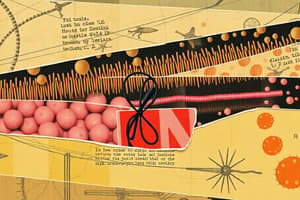Podcast
Questions and Answers
What is the sedimentation rate unit used to describe the size, weight, and shape of a particle?
What is the sedimentation rate unit used to describe the size, weight, and shape of a particle?
- RNA unit
- Micrometer unit
- Centrifugation unit
- Svedberg unit (correct)
What is the composition of ribosomes?
What is the composition of ribosomes?
- Both proteins and pieces of RNA (correct)
- Only RNA molecules
- Only proteins
- Only carbohydrates
What is the function of the 16S rRNA molecule?
What is the function of the 16S rRNA molecule?
- To code for proteins
- To synthesize proteins
- To identify bacteria (correct)
- To regulate gene expression
What is the primary challenge in identifying pathogenic bacteria using traditional methods?
What is the primary challenge in identifying pathogenic bacteria using traditional methods?
What is the purpose of PCR?
What is the purpose of PCR?
What is the advantage of molecular methods in identifying bacteria?
What is the advantage of molecular methods in identifying bacteria?
What is the function of an automatic DNA sequencer?
What is the function of an automatic DNA sequencer?
Why are molecular methods necessary for some bacterial species?
Why are molecular methods necessary for some bacterial species?
What is the purpose of identifying the sequence of the 16S rRNA gene?
What is the purpose of identifying the sequence of the 16S rRNA gene?
What is the goal of the lab exercise?
What is the goal of the lab exercise?
What is the limitation of traditional methods in identifying bacteria?
What is the limitation of traditional methods in identifying bacteria?
What is the primary goal of comparing a newly isolated DNA molecule with all other known sequences?
What is the primary goal of comparing a newly isolated DNA molecule with all other known sequences?
What is the purpose of accessing a comprehensive and up-to-date sequence database?
What is the purpose of accessing a comprehensive and up-to-date sequence database?
What is the result of assigning 1 point for each base pair that matches exactly and 0 points for each base pair that does not in the hypothetical system described?
What is the result of assigning 1 point for each base pair that matches exactly and 0 points for each base pair that does not in the hypothetical system described?
What is the collaboration between GenBank, the EMBL nucleotide sequence database, and the DNA Database of Japan (DDBJ) involved in?
What is the collaboration between GenBank, the EMBL nucleotide sequence database, and the DNA Database of Japan (DDBJ) involved in?
What is the purpose of BLAST search results analysis?
What is the purpose of BLAST search results analysis?
How many points would be assigned to the following sequences: CGGCAT and CGCGAT using the hypothetical system?
How many points would be assigned to the following sequences: CGGCAT and CGCGAT using the hypothetical system?
What is the optimal temperature for Taq polymerase to synthesize complementary strands?
What is the optimal temperature for Taq polymerase to synthesize complementary strands?
What is the purpose of MgCl2 in PCR?
What is the purpose of MgCl2 in PCR?
What is the purpose of the initial denaturation step in PCR?
What is the purpose of the initial denaturation step in PCR?
What is the size of the amplicons of the 16S rRNA gene in bacterial cells?
What is the size of the amplicons of the 16S rRNA gene in bacterial cells?
What is the purpose of the extension step in PCR?
What is the purpose of the extension step in PCR?
What is the confirmatory method used to verify the success of PCR?
What is the confirmatory method used to verify the success of PCR?
What is the purpose of the denaturation step in PCR?
What is the purpose of the denaturation step in PCR?
What is the optimal temperature range for the annealing step in PCR?
What is the optimal temperature range for the annealing step in PCR?
What is the primary advantage of DNA sequencing over other molecular techniques?
What is the primary advantage of DNA sequencing over other molecular techniques?
What is the purpose of adding a primer to the PCR reaction mixture?
What is the purpose of adding a primer to the PCR reaction mixture?
What is the primary consideration when selecting a hybridization temperature for PCR?
What is the primary consideration when selecting a hybridization temperature for PCR?
Who is credited with the development of dideoxynucleotide chain-termination sequencing?
Who is credited with the development of dideoxynucleotide chain-termination sequencing?
Flashcards are hidden until you start studying





